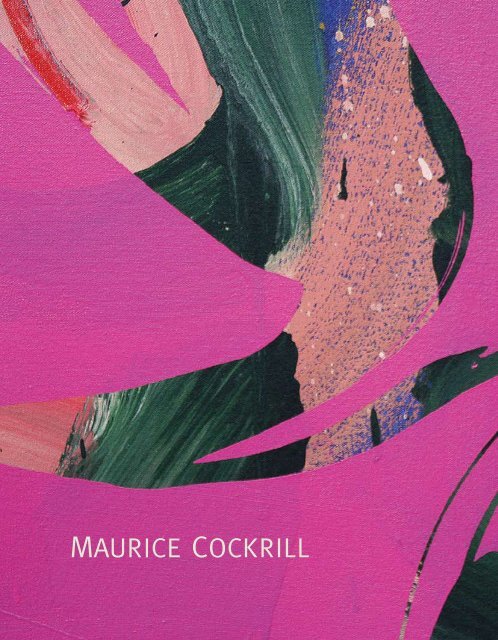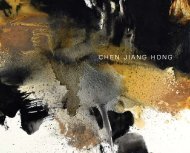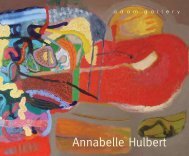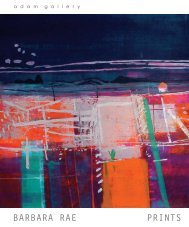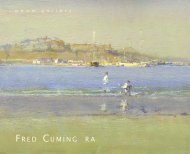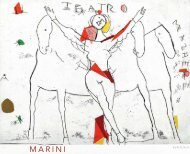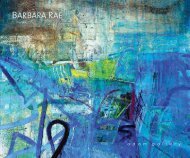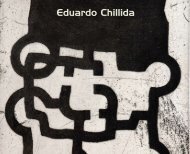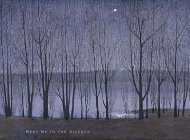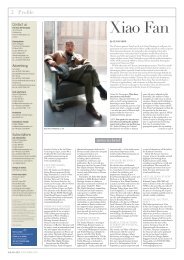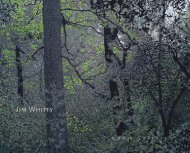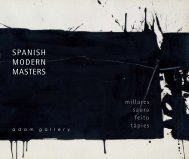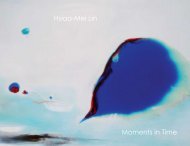'Open Gate' exhibition - pdf catalogue - Adam Gallery
'Open Gate' exhibition - pdf catalogue - Adam Gallery
'Open Gate' exhibition - pdf catalogue - Adam Gallery
Create successful ePaper yourself
Turn your PDF publications into a flip-book with our unique Google optimized e-Paper software.
MAURICE COCKRILL
a d a m<br />
g a l l e r y<br />
MAURICE COCKRILL RA<br />
24 CORK STREET London W1S 3NJ t: 0207 439 6633<br />
13 JOHN STREET Bath BA1 2JL t: 01225 480406<br />
e: info@adamgallery.com www.adamgallery.com
Maurice Cockrill – ‘The Open Gate’<br />
Blessed with a soul well travelled along paths of interpreting our worlds through paint, Maurice Cockrill stuns us with the vivacity<br />
and instinctual approach of a cultivated mind through his new series of works entitled ‘The Open Gate’. A subtle, lyrical thunder<br />
blast of post-modern symbolism with an old soul, the paint is rendered into polarities of violence and softness using an exquisite<br />
sense of colour.<br />
Throughout the decades, Cockrill has opened his eyes to the world again and again, each time shifting the paint in a new way<br />
to reflect each layer of vision. He is famous for his breadth of techniques and themes, saying: ‘the artists I’ve admired most, like<br />
Picasso, are the protean ones. I’d rather be changing shape than just be doing the same thing time after time.’ His paint in the<br />
70’s explored the minutiae surface of objects through the factual effects of photo-realism. Later Cockrill’s work began to explore<br />
the emotional vicissitudes of memory and homeland, plying the paint in raw, vigorous gestures. The colours were dark, sometimes<br />
menacing, and the landscapes: industrial slagheaps of his boyhood. The personal symbols that emerged from this phase propelled a<br />
whole output of more abstracted works reflecting the serpentine rivers winding through the landscapes of his homeland in Wales.<br />
The lyrical curves in the works of this <strong>exhibition</strong> reveal Cockrill’s preoccupation with organic forms, especially water and the phases<br />
of a river. The curves in paintings such as ‘Jade Garden’ (<strong>catalogue</strong> no. .) can be seen as river-maps flowing round the canvases –<br />
reminiscent of his series of pictures such as the ‘Conwy River Cycle’ (1998) – painted in Conwy estuary in North Wales, close to<br />
where the artist grew up. Rivers are important to Cockrill as they evoke the cycle of life – birth, maturity, decay and regeneration<br />
– that echo these central human preoccupations. The artist explains that a proximity to nature – whether in North Wales, or to his<br />
back garden in South London – helps him to address the realm of emotions rather than reason.<br />
Now in ‘The Open Gate’ series, these serpentine shapes have<br />
merged with personal symbols and forms from time spent<br />
in other lands – merging the past and present. The colour<br />
fields that split canvases such as ‘Moonlit Bride’ and ‘Mirror<br />
Mirror’, create a divide and tension of opposites – polarities<br />
finding their unifying paradox in the interweaving forms and<br />
colours. A ‘Mandorla’ is the overlapping spaces of two circles<br />
intersecting – it is the ground upon which the opposites of<br />
the two spaces find their reconciliation. There is a sense here<br />
that the process of painting these opposites: of violence and<br />
softness, darkness and joy, Cockrill is in fact painting himself<br />
into the space of the ‘Mandorla’.<br />
A point has been reached in these new works where there is a<br />
sense Cockrill has finally found what he has been looking for<br />
– the openness, freedom, technical expertise, the use of colour<br />
and paint, are communicating complex ideas with a unifying<br />
simplicity, not unlike the methods found in Chinese scrolls, or<br />
Japanese films. Three large, heavy jade-handled paintbrushes<br />
dangle from hooks in his studio, mighty weights to wield.<br />
Traces of other lands, other philosophies.
As Keeper of the Royal Academy Schools since 2004, Cockrill’s studio perches atop the Royal Academy, reachable by a flight of<br />
Dickensian, dusty and treacherous wooden stairs. When not teaching his students, it is here he paints, listening to jazz, drinking<br />
green tea or reading. Far from epitomising him as a monk however, there are glimmers of a cheeky fascination with the more<br />
violent crime-ridden side of life as revealed in the title of his work ‘Still Alive in the Trunk’ – from the award winning TV series<br />
‘The Sopranos’.<br />
Cockrill works at the heart of the Visual Arts world, and remains one of the most original artists working in Britain today. ‘The<br />
Open Gate’ series is possibly the strongest work Cockrill has created to date, and we are delighted to be exhibiting his new solo<br />
show at the <strong>Adam</strong> <strong>Gallery</strong>.<br />
Maurice Cockrill’s work is in many private and public collections including the British Museum, Arts Council of Great Britain, Walker<br />
Art <strong>Gallery</strong>, Liverpool, and the Royal Academy of Arts. Cockrill’s first major group <strong>exhibition</strong> was Art in the City at the Institute<br />
of Contemporary Arts in London in 1967. Since then, he has held solo <strong>exhibition</strong>s internationally, such as at the Kunstmuseum,<br />
Dusseldorf (1985), Annandale Galleries, Sydney, Australia, and Bernard Jacobson <strong>Gallery</strong>, London and New York. A retrospective of<br />
his work (1974-1994) was held at the Walker Art <strong>Gallery</strong>, Liverpool (1995) and a further retrospective was held at the Royal West<br />
of England Academy (1998).<br />
Prizes have included the John Moores Liverpool Exhibition (1974), the Arts Council of Great Britain, Flags and other projects<br />
(1977), Arts Council of Great Britain major award (1977-8), the Arts Council Works of Art in Public Spaces (1978-9), British Council<br />
Award (1985) and being shortlisted for the Jerwood Prize (1994). Cockrill was elected an RA in 1999, has been Keeper of the Royal<br />
Academy Schools since 2004 and lives and works in London.<br />
Studio photo, cover and no.s 2,3,15 - Maciej Urbanek
Festina lente: the art of Maurice Cockrill<br />
Maurice Cockrill has been surprising us for so many years that surprise might almost be what we expect. There is something<br />
restless and kinetic about his work; also, perhaps, something unsettling. I mean not only that these are the qualities of any<br />
particular painting, but also that the constantly dynamic progress of the work as a whole - progression might be a better term<br />
- from one painting to the next, from one series to the next, from one scale and one medium to another, induces a kind of<br />
nervous exhilaration, or a sense of agitated wonder. His imagination is mercurial; his creative methodologies are resourcefully<br />
experimental; his invention is diverse and virtuosic. Each new phase of his painting presents us with yet another high definition<br />
performance, something not anticipated, as if he was incapable of repeating the previous act, and felt impelled every time to<br />
respond to Diaghilev’s imperious injunction: ‘Étonne-moi!’<br />
To surprise himself also is, of course, part of Cockrill’s creative intent. He has long learnt to let the paint think for him, so to speak;<br />
to trust the medium to find the image, to allow the medium to be the message. This is partly a matter of a versatile and resourceful<br />
technique: Cockrill has constantly found new ways to arrive at desired effects while avoiding premeditation. He may set out not<br />
knowing quite what he wants, but he knows without doubt or question when he has found it. There are elements of both Zen<br />
and surrealism in these strategies. He is a consummate master of the unpredictable linear sign, of the arabesque, the interweaving<br />
serpentine, the quick and sudden automatic gesture. He is a brilliant and original colourist.<br />
In all this, Cockrill draws on a deep understanding of the diverse histories of modern and post-modern art, including those of both<br />
realist and abstract expressionism. This insight is developed through intuitive openness, meditative reflection and long practice.<br />
He has, as well, a canny grasp of formalist device, a purposive structural intelligence and a ready visual wit. There are everywhere<br />
in his paintings the discernible traces of his creative negotiations with the art of the past, with that of the modernist masters<br />
and with that of his best contemporaries. This energetic exchange gives his paintings a particular and characteristic vibrancy of<br />
formal and thematic reference. His quick and pungent manner, at once unpredictable and unmistakeable, is his own: the product,<br />
paradoxically, of sometimes prolonged contemplation. For Maurice Cockrill knows when to wait, and when not to; how to be<br />
uncertain the better to achieve a surprising certainty of image and effect. When the work arrives in our sight, we applaud the<br />
brilliant performance, and immediately think: what will he do next?<br />
Mel Gooding
1 His Little Princess<br />
mixed media on canvas 120 x 100cm
2 Well You Needn’t<br />
mixed media on canvas 240 x 200cm
On this precious night<br />
How I wish that I could show,<br />
If I am to view them,<br />
To someone who knows how to feel,<br />
These blossoms and this moon.<br />
Japanese poem - Anonymous; Tenth century<br />
MC<br />
3 Birds of Passage<br />
mixed media on canvas 180 x 120cm
4 Broken Nocturne - Lemon<br />
mixed media on canvas 100 x 80cm
5 Jade Garden<br />
mixed media on canvas 60 x 50cm
6 Child Bride<br />
mixed media on canvas 30 x 25cm
7 Salome<br />
mixed media on canvas 120 x 100cm
8 Anticipated Blues<br />
gouache on paper 29 x 39cm
9 At The Swimming Hole<br />
mixed media on canvas 120 x 100cm
10 Little Warrior<br />
mixed media on canvas 30 x 25cm<br />
11 Flame<br />
gouache on paper 40 x 28cm
12 Shinto Trees<br />
mixed media on canvas 100 x 80cm
13 The Liberator<br />
mixed media on canvas 60 x 50cm
14<br />
Fire Bird<br />
mixed media on canvas 100 x 80cm
15 The Torn Curtain<br />
mixed media on canvas 150 x 120cm
16<br />
Winter Journey II<br />
mixed media on canvas 100 x 80cm
17 Falling Hopes<br />
mixed media on canvas 100 x 80cm
18 Rain on the Soldier<br />
gouache on paper 39 x 29cm
19 Eve, <strong>Adam</strong> and the Eye of God<br />
mixed media on canvas 100 x 80cm
20 Dancing in the Month of May<br />
gouache on paper 59 x 45cm
21 Assignation in the Month of May<br />
mixed media on canvas 100 x 80cm
22 Envy<br />
mixed media on canvas 60 x 50cm
23 Mirror Mirror<br />
mixed media on canvas 60 x 50cm
24 Rockaway<br />
mixed media on canvas 60 x 50cm
25 Three Friends of the Cold Season<br />
mixed media on canvas 100 x 80cm
26 White Column<br />
mixed media on canvas 30 x 25cm<br />
27 Broken Ladder<br />
mixed media on canvas 41 x 31cm
28 Still Alive in the Trunk<br />
mixed media on canvas 60 x 50cm
29 Moonlit Bride<br />
mixed media on canvas 60 x 50cm
Maurice Cockrill - Biography<br />
1936 Born, 8 October, Hartlepool, UK<br />
1958-60 Studied at Wrexham School of Art, National Diploma in Design and Painting Special<br />
1960-64 University of Reading, Art Teacher Diploma & BA in Fine Art<br />
1967-80 Lecturer, Faculty of Art, Liverpool Polytechnic<br />
1982 Moves to London<br />
1982-85 Occasional visiting tutor at Schools of Art in Manchester, Portsmouth,<br />
Farnham, Winchester and Nottingham<br />
1985-88 Visiting tutor at Royal College of Art and Central School of Art<br />
1984-94 Visiting tutor at Saint Martins School of Art<br />
1994 Nominated for the Jerwood Prize<br />
1995 Artist in Residence at G.O.F.A. University of N.S.W. Australia<br />
1995-97 Visiting tutor at Royal Academy Schools<br />
1999 Elected to the Royal Academy of Arts<br />
2002 Visiting Artist, Vermont<br />
2004 Visiting Artist, Vermont Studio Center<br />
2004 Elected the Keeper of the Royal Academy of Arts and Head of the Royal Academy Schools<br />
2005 Honorary Member of Royal West of England Academy<br />
2006 President of the Royal Cambrian Academy<br />
2006 Professor of Contemporary Fine Art in Liverpool John Moores University<br />
2007 Honorary Member of Royal Watercolour Society<br />
2007 Guest Professor, Xi’an Academy of Fine Art, China<br />
2008 Honorary Fellow of Glyndwr University<br />
Collections<br />
British Museum<br />
Arts Council of Great Britain<br />
Welsh Arts Council<br />
Walker Art <strong>Gallery</strong>, Liverpool<br />
Ulster Museum, Belfast<br />
Hertfordshire Education Committee<br />
The Leicester Collection<br />
London Borough of Candem<br />
University of Liverpool<br />
Liverpool Daily Post<br />
Alexander Howden Group<br />
Borough of Milton Keynes<br />
John Moores, Liverpool<br />
D.G. Bank Atkinson Art <strong>Gallery</strong>, Southport<br />
Granada Television<br />
Merseyside Arts<br />
Kunstmuseum, Düsseldorf<br />
Contemporary Art Society<br />
Deutsche Bank<br />
Unilever<br />
Centro Cultural Arte Contemporaneo, Polanco, Mexico<br />
Riggs Bank AG, London<br />
Royal Academy, London<br />
Contemporary Art Society for Wales
Selected Solo Exhibitions<br />
2009 <strong>Adam</strong> <strong>Gallery</strong> , London ‘The Open Gate’<br />
2009 Charleston, East Sussex, UK<br />
2007 Cheltenham Museum and Art <strong>Gallery</strong><br />
2007 Francis Kyle <strong>Gallery</strong><br />
2006 Dover Arts Club<br />
2004 Archeus Fine Art, London<br />
Royal Cambrian Academy, Conwy, Wales<br />
Attic <strong>Gallery</strong>, Swansea<br />
Williamson Art <strong>Gallery</strong>, Birkenhead<br />
Galerie Bruno Mory, Besanceuil, France<br />
Hillsborough Fine Art, Dublin<br />
2002 Archeus Fine Art, London<br />
2002 Royal Academy, London, Friends’ Room Exhibition<br />
2001 Galerie Helmut Pabst, Frankfurt<br />
2000 Galerie Bugdahn und Kaimer, Düsseldorf<br />
Galerie Vidal-Saint Phalle, Paris<br />
1999 Annandale Galleries, Sydney Australia<br />
1998 Galerie Bugdahn und Kaimer, Düsseldorf<br />
Royal West of England Academy, Bristol. Retrospective<br />
Purdy Hicks <strong>Gallery</strong>, London<br />
Galerie le Triangle Bleu, Stavelot, Belgium<br />
Galerie Helmut Pabst, Frankfurt<br />
Ogilvy and Estill <strong>Gallery</strong>, Conwy, Wales<br />
1997 Galerie Clivages, Paris<br />
Galerie Helmut Pabst, Frankfurt<br />
Belgrave <strong>Gallery</strong>, London; works on paper<br />
1996 Annandale Galleries, Sydney, Australia. Drawings<br />
Bernard Jacobson <strong>Gallery</strong>, London ‘A Portable Kingdom’<br />
1995 Galerie Helmut Pabst, Frankfurt<br />
Retrospective 1974-1994, Walker Art <strong>Gallery</strong>, Liverpool<br />
Bernard Jacobson <strong>Gallery</strong>, London ‘Place of Fire’<br />
Galerie Clivages, Paris The Ash Series<br />
Annandale Galleries, Sydney, Australia<br />
Djanogly <strong>Gallery</strong>, University of Nottingham, Retrospective<br />
1994 Galerie Helmut Pabst, Frankfurt<br />
Galerie Molinaars, Breda, Holland, Works on Paper<br />
1993 Bugdahn und Kaimer, Düsseldorf<br />
1992 Bernard Jacobson <strong>Gallery</strong>, London<br />
Newlyn Art <strong>Gallery</strong>, Penzance<br />
Spacex <strong>Gallery</strong>, Exeter<br />
1992 Plymouth Art Centre, Plymouth<br />
1988 Bernard Jacobson <strong>Gallery</strong>, New York<br />
1987-90 Bernard Jacobson <strong>Gallery</strong>, London<br />
1986 Galerie Bugdahn und Szeimies, Düsseldorf<br />
1985 Kunstmuseum, Düsseldorf<br />
1984-85 Edward Totah <strong>Gallery</strong>, London<br />
1983 University of Nottingham <strong>Gallery</strong><br />
1981 Festival Commission, Milton Keynes<br />
1981 Bluecoat <strong>Gallery</strong>, Liverpool<br />
1979-80 Lime Street Station, Liverpool<br />
1979 St. Paul’s <strong>Gallery</strong>, Leeds<br />
1976 Liverpool Academy <strong>Gallery</strong><br />
1974-79 Bluecoat <strong>Gallery</strong>, Liverpool<br />
1971 Serpentine <strong>Gallery</strong>, London<br />
Peterloo <strong>Gallery</strong>, Manchester
a d a m<br />
g a l l e r y<br />
www.adamgallery.com<br />
24 CORK STREET London W1S 3NJ t: 0207 439 6633<br />
13 JOHN STREET Bath BA1 2JL t: 01225 480406


